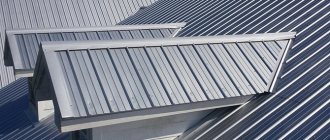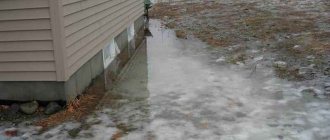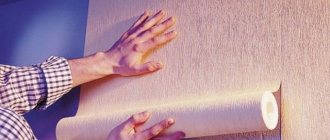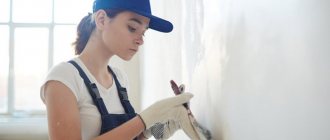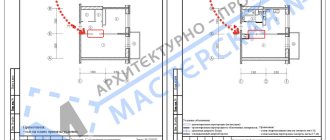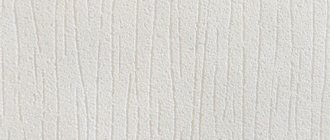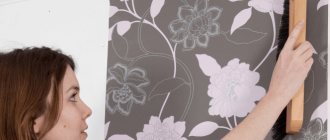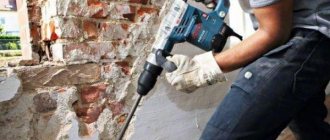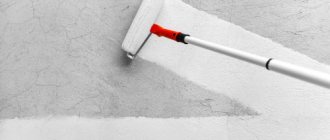The fact is that wallpaper is the most traditional and long-known finishing material. Well, what does this word mean to us? A certain rolled material, usually with a paper backing (but in some cases without it), which is attached to the surface of the walls with glue.
Upon carefully delving into the topic, it turned out that there are so many types of these same wallpapers: your eyes will run wild until you choose something suitable, beautiful and comfortable.
Wallpaper classification
By water resistance:
- REGULAR. Such specimens do not withstand exposure to water; they only require dry wiping (wiping individual contaminated areas with a cloth or vacuuming, but without the brush coming into contact with the wallpaper);
- WATER RESISTANT. These, on the contrary, can withstand wiping lightly soiled areas with a damp sponge or soft cloth without the use of detergents;
- WASHABLE - withstands water cleaning with the addition of detergents;
- HIGH RESISTANCE - VINYL. Everything is clear with these, they can withstand everything described above and even more.
By surface type:
- SMOOTH;
- WITH RELIEF PATTERN applied to the surface during the production process;
- WITH AN EMBOSSED SMALL PATTERN;
- WITH DEEP PATTERN, multi-layered.
By density:
- LUNGS;
- HEAVY (with a density of less than 110 g/m², there are significant difficulties with gluing stripes in the presence of unevenness on the base; denser wallpaper has a positive effect on the microclimate in the room).
Depending on the picture:
- SMOOTH SINGLE COLOR;
- PATTERNED (without a repeating pattern that requires adjustment of adjacent stripes when sticking).
On average, our wallpaper lasts 4-5 years. But this is only under the conditions, under the standards that they (that is, we, their owners) are obliged to observe: firstly, the standard of light resistance, which must be at least 6 VG of the eight-degree blue scale. Therefore, the owners are required to ensure the correct arrangement of furniture so that almost full daylight falls on the wallpaper. Where they do not receive light, they quickly deteriorate and fade. Secondly, the norm of vapor permeability, which should be at least 100 g/m2 in 24 hours. This condition greatly affects the microclimate of the room.
The general conditions for individual wallpaper batches include:
- checking the average density by weighing three samples measuring 10x10 cm with an accuracy of 0.01 g;
- steam conductivity check - in gr. per unit surface and time;
- testing resistance to wet wiping by wiping a sample of wallpaper with a damp swab, covered with flannel and loaded with a mass of 100 g (after 10 movements of 100 mm each, the swab should not become dirty, and the surface of the samples should not be damaged);
- determination of resistance to washing by a method similar to the previous one, but the swab is moistened with water with the addition of detergents (after 50 movements the swab should not become dirty, and the surface of the samples should not be damaged);
- determination of resistance to light.
Basically, this is all general information. And in order not to dwell on general points, let’s move on to a more detailed study of the wallpaper phenomenon. Everyone here will get the necessary information for themselves and make conclusions and choices. Correct!
Well, now to the most interesting thing: here are the most popular and widespread TYPES OF WALLPAPERS, especially in our country, of which something should obviously appeal to you!
Features of operation
If you are going to update the interior, it is not necessary to tear off the fiber wallpaper and replace it with new ones; it will be enough to simply repaint it. That is, the material will be used for a long time, and therefore you should immediately purchase high-quality wallpaper, for example, made in Germany.
The quality of building materials from Germany is widely known among professionals in the repair and construction market.
Germany is famous for its specialists who are meticulous about the production process and ensure that absolutely all production standards are met.
Paper wallpaper
Of course, paper wallpaper remains the most beloved and most widely used. This is explained, first of all, by their comparative cheapness and simplicity of installation technology. In addition, they are environmentally friendly, allow walls to “breathe”, and can be used to decorate almost any residential premises with low air pollution and humidity. And their inherent relative fragility (only some imported samples are designed for a service life of 5-10 years) is fully compensated by their low price. Paper wallpaper slightly reduces the thermal conductivity of walls and increases sound absorption. Significant disadvantages of paper wallpaper are low strength, especially evident during the pasting process, and the impossibility of using it in wet rooms that require treating the walls with detergents.
From an aesthetic point of view, modern paper wallpapers, with their variety of colors and structures, can satisfy even the most sophisticated taste. Smooth and textured wallpapers are available, with or without a pattern, and even designed for further painting and impregnation with a water-repellent composition. Paper wallpaper with a structured surface has an interesting decorative effect. This can be duplex embossed wallpaper, which consists of two interconnected sheets of paper, embossed while still wet. Or there can be coarse-fiber wallpaper, also consisting of two layers of paper, between which a layer of wood chips is placed. Of these materials, the most popular are German wood-fiber wallpaper Bauhfaser and embossed wallpaper Novaboss, which have gained good fame among both finishers and designers. Both products are environmentally friendly, do not change their structure when glued to walls, hide minor wall defects, and can withstand up to 15 painting cycles.
Thanks to the evenly structured surface of such wallpaper, the pasted wall has a beautiful appearance, which is achieved not with the help of ornaments, but as a result of a kind of light refraction that enlivens the entire pasted surface. On such structured, monochromatic surfaces, interior items, paintings, drapes, curtains look advantageous.
Vinyl wallpapers
Recently, along with traditional paper wallpaper, vinyl wallpaper, which appeared relatively recently, has become very popular. This wallpaper is formed from two layers - the bottom layer of paper (or fabric) is covered with a layer of polyvinyl, and then a pattern or embossing is applied to the surface. Foamed wallpaper, in which the top layer of vinyl has acquired an additional structure as a result of heat treatment, is denser and covers the wall surfaces well.
Another type of vinyl wallpaper - silk-screen - has silk threads in the top layer of vinyl. Most often, this type of wallpaper is dark-colored, smooth or embossed. This group of materials is united by increased decorativeness and resistance to light exposure. Significant strength, elasticity and water resistance of the top layer allow the use of vinyl wallpaper for covering premises that require frequent wet cleaning with the use of detergents, i.e. They are used for pasting kitchens, bathrooms, hallways, and halls.
Working with vinyl wallpaper, of course, is still difficult. Due to their significant thickness, vinyl wallpapers, which have a moisture-resistant vinyl layer, prevent the passage of excess moisture. In addition, they have a high coefficient of linear stretching; when glue is applied, they stretch greatly, and when dried, they shrink. As a result, the seams between the wallpaper panels may come apart. Vinyl wallpaper also does not tolerate changes in temperature and humidity very well.
But vinyl wallpaper is perhaps the most interesting type from a decorative point of view. The manufacturing technology of vinyl wallpaper allows you to create such a variety of coating options that this material can rightfully be considered multifaceted.
How to stick
Fabric wallpaper should always be applied from a corner, observing the direction of the pattern on the surface. In order not to get confused in this process, the walls are covered with markings. It is important that each canvas is glued only end-to-end. There are no other options for this species.
Before fixing the first part, a gap of 3–4 cm is left. The base is pressed against the wall surface only with the help of a rubber roller. Movements should be smooth and slow. Gradually work your way down to remove excess air.
Textile wallpaper
Textile wallpaper is a paper sheet laminated with threads of natural or mixed fibers, or natural fabric. Their production technology consists of several processes:
- Formation of textile fabric. For this, various types of yarn or threads are used, consisting of natural (linen, cotton) or mixed fibers. The thread fabric can be formed from a different number of threads depending on their thickness and packing density. The number of threads ranges from 25 to 150 per 10 cm of paper web width;
- Forming wallpaper. The process consists of applying glue to a paper base and pressing it with a thread cloth;
- A drying process consisting of passing a paper web laminated with threads through 5-6 drying chambers using infrared radiation. The result of the drying process is a finally formed roll of wallpaper up to 1000 m long; cutting and packaging is the final stage at which the large roll is cut into standard (10.05 m long) or other lengths at the request of the customer.
Such wallpaper can be produced in various widths - from 53 to 80 cm. Textile wallpaper has increased heat-insulating and noise-absorbing properties, light resistance; This is an environmentally friendly product. This wallpaper belongs to the group of materials that do not burn easily, and materials containing flax fibers have bactericidal properties. Currently, wallpaper is produced from cotton, viscose and linen threads, as well as from threads containing natural and artificial fibers. The use of various threads makes it possible to provide any color scheme and, thus, satisfy the most sophisticated tastes of customers and the highest requirements of modern design. Synthetic-based textile wallpapers, which are textile fabric glued to foam rubber, are also produced.
A special type is velor wallpaper. They are paper sheets on which, during the production process, a pattern is first applied, and then velor fibers are applied. The result is a soft velvet surface.
Textile wallpaper is intended for covering walls and ceilings of office, residential and administrative premises in the usual way. They do not require adjustment to the pattern, which is a significant advantage over traditional paper ones. The unique texture of the fabric ensures that the strips are seamlessly connected to each other and imitate a continuous fabric surface.
The best manufacturers of textile coverings
At the moment, the first places are shared by manufacturers from Italy and Germany; France and Belgium can also be added to the list.
When identifying the best manufacturers, the following criteria are taken into account: cost, quality of additives used, width and length of the roll, relief and the presence of designs, patterns, uniqueness of the design finish.
The cost is calculated based on the materials used. So, natural products like silk, linen, etc. significantly more expensive than synthetic ones.
All of these manufacturers mostly produce 10-meter rolls. 1 sq.m. on average it costs about 500-600 rubles. Custom-made canvases vary in price and size. So, the cost of 1 sq. m. can reach up to 2000 rubles, and the size can be 87 x 100 cm.
The best companies from these countries are:
- Sangiorgio
- Zuber
- Arlin
- Rasch
- Calcuta et al.
Linkrust
A variety of valuable types of wallpaper is linkrust. It has a paper base, and unlike ordinary wallpaper, it is covered with a thin layer of mass consisting of lonoxin, vinyl chloride and other mastics with wood flour or other fillers. The elastic mass allows you to squeeze out a wide variety of patterns and ornaments. This wallpaper has a long service life, can be painted with oil paint and makes it easier to keep the wall surface clean than regular wallpaper.
Liquid wallpaper
Recently, coatings that have received the trade name “liquid wallpaper” have gained particular popularity. This material allows you to create smooth or textured coatings without seams. The coating composition may include cotton, cellulose, textile fibers. “Liquid wallpaper” is diluted with water-based paint and applied with a roller or spray gun. Tinting of “liquid wallpaper” is done with special paints. The advantage of the material is the ability to apply it to concrete and plasterboard surfaces that do not have significant defects (chips, holes). Coatings are supplied to the Russian market in powder or liquid form.
Advantages and disadvantages of fabric canvases
Among the main advantages of the coating are:
- steam conductivity;
- sound and heat insulation;
- naturalness of the materials used;
- air permeability, formation of uniform oxygen circulation indoors;
- wide range of products and unique design finishes.
The main disadvantages include mainly the inevitability of dust accumulation. Due to the presence of this factor, sticking in a nursery is not very recommended.
In addition, due to poor moisture resistance in the bathroom and kitchen, this coating is not very useful for long-term service.
Wallpaper based on serpyanka
Wallpaper based on serpyanka is a new material for domestic builders. They are produced by a German company called Profideco. This is a rolled material consisting of two layers. The basis of the wallpaper is non-woven cellulose fabric. A finishing layer of foamed cellulose is applied to it. As a result, rolls of wallpaper with a width of 1.06-25 m (for professional finishing) and a standard size of 0.53x10 m (for private consumers) are obtained. The characteristics of Profideco wallpaper comply with GOST 6810-86 “Wallpaper. Technical conditions".
The new material has a number of significant advantages over other roll materials such as wallpaper.
With the help of a finishing layer of foamed cellulose, more than 60 types of patterns and textures are obtained that imitate large and small structural plasters (for various rooms), “ceiling” structures, and various fabrics. The technology allows you to create not only coverings for the main area of the wall, but also finishing elements: upper and lower borders.
The natural color of Profideco wallpaper is white. The coatings can be used without additional finishing (ceilings) or painted with dispersion, latex and acrylic paints. This allows the designer to implement traditional and trendy interior solutions in rooms of various functional purposes, as well as significantly increase the wear resistance of coatings.
The material has vapor diffusion properties, which allows the covered surfaces to “breathe”. At the same time, the strength of Profideco wallpaper when gluing is significantly higher than, for example, that of ordinary paper. The wallpaper strips have a stable shape: they do not stretch during operation, do not “shrink” when the glue dries, and do not twist.
Now Profideco wallpapers are gaining increasing popularity not only in Germany, but also in Russia.
How to properly glue non-woven wallpaper?
First of all, you need to prepare the wall for gluing:
- Remove old wallpaper
- Remove old paint or sand it with sandpaper (medium)
- Level the surface
- Prime
After that, cut the wallpaper. If your wallpaper does not have a pattern or it does not need to be adjusted, it is enough to cut the wallpaper into strips equal to the height of the ceilings plus 5-7 centimeters at the bottom and top. If there is a pattern on the wallpaper, the wallpaper must be cut so that the pattern matches when applied.
Next, you should prepare a special glue for non-woven wallpaper in accordance with the included instructions. As a rule, the glue needs to sit for fifteen minutes to half an hour. When the glue is ready, apply it to the wall.
The wallpaper sheet is mounted dry on the wall. The strips are glued together. It is better to start from the corner from the window - then the seams will be practically invisible.
After the strip of wallpaper is pasted on the wall, trim off the excess wallpaper at the top and bottom, and remove excess glue with a rag. It is necessary to wipe the glue off the vinyl coating very carefully, because it is very fragile!
Read more: How to glue wallpaper?
Glass wallpaper
Some time ago, a relatively new material for wall decoration appeared on the Russian market - fiberglass wallpaper, which has been successfully used abroad for about 50 years.
The basis of the material is fibers made of special glass, which are pulled through dies in a platinum “boat” at a temperature of about 1200°C. They are then spun into yarn and woven. The result is a woven fabric with different patterns.
The raw materials for the production of glass wallpaper are mineral, environmentally friendly materials: quartz sand, soda, lime, dolomite. Thus, there is no nutrient medium for microorganisms. Glass is a dielectric, so there is no possibility of electrostatic charge accumulation. Glass wallpaper does not cause allergies and does not emit toxic substances into the air. At the same time, glass wallpaper has high fire safety, vapor permeability, water resistance, alkali and acid resistance.
Fiberglass wallpaper is usually supplied in rolls 1 m wide. The roll area is up to 50 m2. The chemical composition of fiberglass wallpaper determines the possibility of their use on surfaces of various natures. Wallpaper can be pasted on concrete and brick surfaces, drywall and chipboard (fibreboard), cleaned from dust and other contaminants, wooden and metal bases. By following some simple rules, with the help of glass wallpaper you can, for example, in old buildings, achieve structural and color unification of surfaces and give the premises a modern aesthetic appearance. For builders, an important quality of glass wallpaper is the ability to hide small cracks, rusts, and seams between panels, obtaining a perfectly smooth structured surface, ready for further finishing. These wallpapers are used in residential premises, offices, hotels, and medical institutions, as they help maintain the indoor microclimate.
What kinds of wallpaper are there for walls, where is it best to use them?
Page navigation
In order not to drown in endless wall design options, it is better to start by setting your own priorities. According to the recommendations of experts, before purchasing paintings and repairs, first determine their purpose:
- durability or environmental friendliness;
- originality or budget;
- the need to hide uneven walls or moisture resistance;
- the ability to quickly and easily change the color or a specific design that will become a “feature” in the interior;
- Maybe there are animals in the house and the material needs resistance to mechanical damage.
Once the basic requirements for the material become clear, it will be easier to decide on the types of wallpaper for the walls.
Based on its functionality, structure, thickness and design, the classification is as follows:
- Fabric structure. There is a smooth surface with a relief, embossed with a small pattern, multi-layered.
- Thickness. Thin wallpapers have a low density and, therefore, require perfectly smooth walls. Dense ones are generally less demanding on surface preparation.
- By production design. Plain, patterned, smooth surface, relief, using various materials (usually textile or natural).
- By method of application. In liquid form or in sheets of different sizes.
Moisture resistance of canvases plays an important role.
Moisture resistance deserves special mention:
- Non-moisture resistant ones do not tolerate moisture well. Maintenance is possible only by dry cleaning.
- Moisture-resistant do not deform when treated with a damp sponge, without the use of chemicals.
- Washable ones tolerate moisture well; surfactant-based products can be used for care.
- Highly resistant to water, they can be cleaned not only with household chemicals, but also with a brush.
What types of wallpaper are there based on
In this case, the choice today is huge:
- paper (regular wallpaper);
- vinyl;
- non-woven;
- textile;
- glass wallpaper;
- liquid wallpaper;
- flock;
- velor;
- photo wallpaper;
- acrylic wallpaper;
- metal;
- bamboo.
Each type has its own characteristics, pros and cons. A house or apartment consists of many rooms with their own functionality and corresponding requirements. And by combining these two criteria, it will be easier to choose the appropriate finishing material for each specific zone.
When choosing a paper version, it is worth remembering that this is wallpaper of the most budget class.
Paper wallpapers are made from different types of paper or waste paper. In principle, they can do a good job of masking small unevenness in the walls. They are divided into 2 main groups: simplex (single-layer fabric) and duplex (several layers).
The latter option is considered to be of higher quality and is better suited for external alignment of walls. It is considered an environmentally friendly material.
The designs are varied: embossed, white for painting, a huge selection of designs and patterns. However, paper webs quickly “fail” and lose their presentation due to exposure to sunlight or mechanical damage.
Their use in the bathroom, kitchen and toilet is highly discouraged due to their low resistance to moisture and high ability to absorb odors. Only at first, after using them for a short time, it seems that they managed to improve the interior, but over time comes disappointment and the need for unscheduled repairs.
Vinyl is the most common
Vinyl - those wallpapers that contain paper or non-woven material as a base. The second, top layer is vinyl (or the correct name is polyvinyl chloride). Antifungal drugs may also be added to the composition.
They belong to the class of washable, resistant to dirt and mechanical damage. Structurally, they are divided into 2 main categories: non-embossed and hot embossed.
The latter are divided into 4 main types:
- The embossing is done chemically. The main advantage is resistance to the sun and the ability to use cleaning agents.
- Silkscreen printing. Embossing using high quality acrylic or silk threads. A very popular option, but requires a flat surface.
- Compact vinyl. In appearance it is similar to heavy materials - stone, plaster. The main advantage is resistance to mechanical damage.
- The so-called heavy vinyl. Gained popularity due to its ability to level out significant wall defects.
Vinyl wallpaper can be wet cleaned, it is resistant to mechanical damage and retains its decorative properties for up to 15 years.
The main disadvantage is the flammability of the material. The smoke from them contains chloride compounds. For this reason, they are prohibited in some European countries. Everything you need to know about wallpaper is studied in advance, so that in the store all that remains is to choose the design of the canvases.
Cork wallpaper
The base is cork oak bark. Prepared by hot pressing at t = 360-400°C. This releases adhesive substances from the cork. Thus, the cork seems to glue itself. Cork wallpaper has antibacterial properties.
Wallpaper based on wood veneer.
Veneer made of valuable wood species (~0.1 mm thick) applied to special thick paper is sold in the form of a canvas 50-70 cm wide or in sheets 50-70 cm in size. Such wallpaper creates a feeling of warmth and, in essence, is not as expensive as the corresponding upholstery with wood panels. Natural “plywood” wallpaper should not be confused with plastic “wood” wallpaper.
Carpet wallpaper (tufted wallpaper)
If you want to decorate the walls and floor with carpet, then try using carpet wallpaper with sewn-on pile (“tufted wallpaper”). Tufting means pile, and tufted wallpaper is pile attached to a fabric backing. This decorative finish looks good, absorbs sound and retains heat. This wallpaper is made from 100% synthetic fiber, is insensitive to humidity and relatively fire resistant. They are glued with regular wallpaper glue.
Polina Lichagina Courtesy: www.idh.ru
